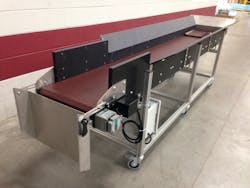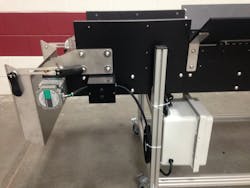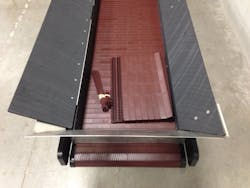A Conveyor Designed for Blow Molding
Packaging companies all over the world rely on closed-loop blow molding to manufacture millions of plastic bottles and containers. The process is hot and requires forming and moving thousands of containers through machines with cramped interior space while separating out and recycling scrap. And those machines often require adjustments and maintenance.
With all that it mind, managers at Dynamic Conveyor Corp. worked with their engineers to devise a conveyor that could handle all those challenges. Known as the Hybrid conveyor, it lets customers choose between features the company has developed for its various lines of conveyors.
Here are features Dynamic Conveyor provides for blow molders.
Temperature Resistance
Standard belts on most conveyors are made of polypropylene; they withstand sustained temperatures of 210°F and short-term exposure to 300°F temperatures. But blow-molded containers are usually made of high-density polyethylene (HDPE), which melts at an average temperature of 400°F. (This is the temperature at which the material flows.)
In blow molding, the belts must survive exposure to the bottles as they are formed and cooled. This led Dynamic Conveyor engineers to choose a version of nylon for the belt that withstands sustained temperatures of 310°F. In fact, all contact surfaces, including the sidewalls, on the Hybrid conveyor are made of temperature-resistant nylon that can even handle the high temperatures of molten plastic.
But the belt must also handle purges, a process in which technicians make sure the HDPE is properly heated and flowing consistently. So, in a purge, technicians let a shot of molten plastic flow out of the blow-molding machine and directly into the conveyor to examine it. If it is not the right consistency, they wait and repeat the process until the plastic is flowing just right. The plastic globs sit on the belt until they solidify, and then get recycled. The belts must handle that heat as well.
“Temperatures during a purge can be as high as 500°F,” says Paul Kuharevicz, a sales project engineer at Dynamic.
Purging is also done when it’s time to change the color of the bottles being made. For example, if scheduled to go from white to green bottles, molten white plastic is purged from the machine until pure green molten plastic is being expelled.
Separation and Closing the Loop
After the bottles have been formed and are travelling down the conveyor cooling, a machine automatically trims the plastic flashing from the top and bottom of the mold—the “tips and tails.” These fall onto the moving conveyor along with the more-finished bottles. As the conveyor exits the machine, it sends its load across an adjustable gap that lets the conveyor act as a separator.
The smaller tips and tails fall through the gap and down onto another conveyor, this one taking them to a grinder. They are ground then sent back through the blow-molding process as raw material. This makes it a closed-loop process, one with no material waste.
The larger bottles make it over the gap and down the chute onto yet another conveyor. It takes them to a pack-out table where they are boxed for shipment to the customer.
Keeping it Compact
Hybrid conveyors have features that let them fit into the tight spaces often found inside well-designed blow molding machines. For example, to get a conveyor through the blow-molding machine’s small opening, hinges along one side let it fold up, making it thinner. That side is folded down when installation is complete.
Conveyor widths range from 2 to 120 in., and lengths can be up to 100 ft. Sidewall heights are as low as one inch. Unlimited angles and geometries let plant engineers create conveyor lines with precise inclines, declines and lateral turns to fit into awkward spaces and match perfectly with other equipment.
“Customers can specify conveyors that work well with their chosen brand of blow molding equipment,” says Kuharevicz. “We have put these with Bekum H-155 and Nissei NEX 110 blow molders.
Simplifying Maintenance
Blow-molding machines need moving conveyors to be productive, and mishaps can be costly. For example, one typical problem for conveyors in blow molding machines is that workers often stand on them when changing molds or drop heavy wrenches onto the belt and punch a hole through the belt.
“That’s why we recommend rolling conveyors out of the machine—they can be equipped with wheels—and not to use them as ladders or worktables,” says Kuharevicz.
But accidents happen, and to minimize that downtime, the Hybrid conveyor uses a link-style belt. It can be repaired quickly and easily without specialized labor. If large section of the belt is damaged, it can be replaced within minutes, eliminating the need to replace the entire belt. This is a feature “borrowed” from the company’s DynaCon Conveyor.
“We knew there were thousands of blow-molding machines in the U.S. and throughout the world, so it wasn’t a big stretch for us to make conveyors specifically designed for them,” says Kuharevicz. “Our only regret is not creating this conveyor years ago. The company is now developing a conveyor that withstands extremely high and low levels of PH, acids and bases—a chemically resistant conveyor. Once again, we understand the market for this is huge and if we design and manufacture produce a superior product, it will sell itself.”
To get a visual overview of the blow-molding process, watch this video:



